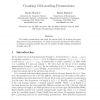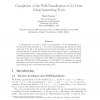72 search results - page 2 / 15 » Permutations Avoiding Two Patterns of Length Three |
COMBINATORICS
2004
13 years 4 months ago
2004
We study the distribution of the statistics `number of fixed points' and `number of excedances' in permutations avoiding subsets of patterns of length 3. We solve all th...
COMBINATORICS
2002
13 years 4 months ago
2002
We consider permutations that avoid the pattern 1324. By studying the generating tree for such permutations, we obtain a recurrence formula for their number. A computer program pr...
DM
2006
13 years 4 months ago
2006
We complete the enumeration of Dumont permutations of the second kind avoiding a pattern of length 4 which is itself a Dumont permutation of the second kind. We also consider some ...
CORR
2006
Springer
13 years 4 months ago
2006
Springer
In this paper, we give a polynomial (O(n8)) algorithm for finding a longest common pattern between two permutations of size n given that one is separable. We also give an algorithm...
COMBINATORICS
2006
13 years 4 months ago
2006
A permutation is said to avoid the permutation if no subsequence in has the same order relations as . Two sets of permutations 1 and 2 are Wilfequivalent if, for all n, the numb...


